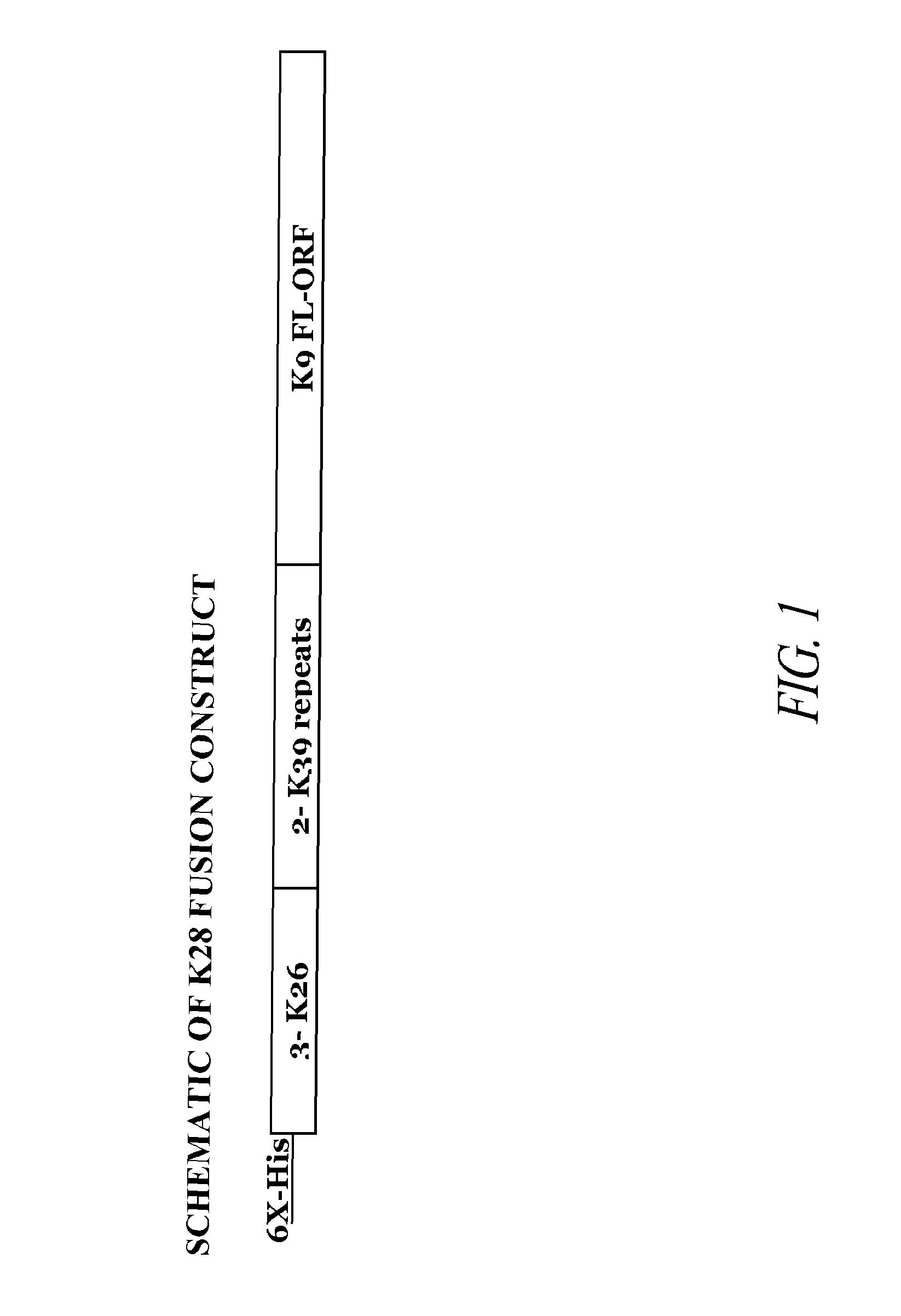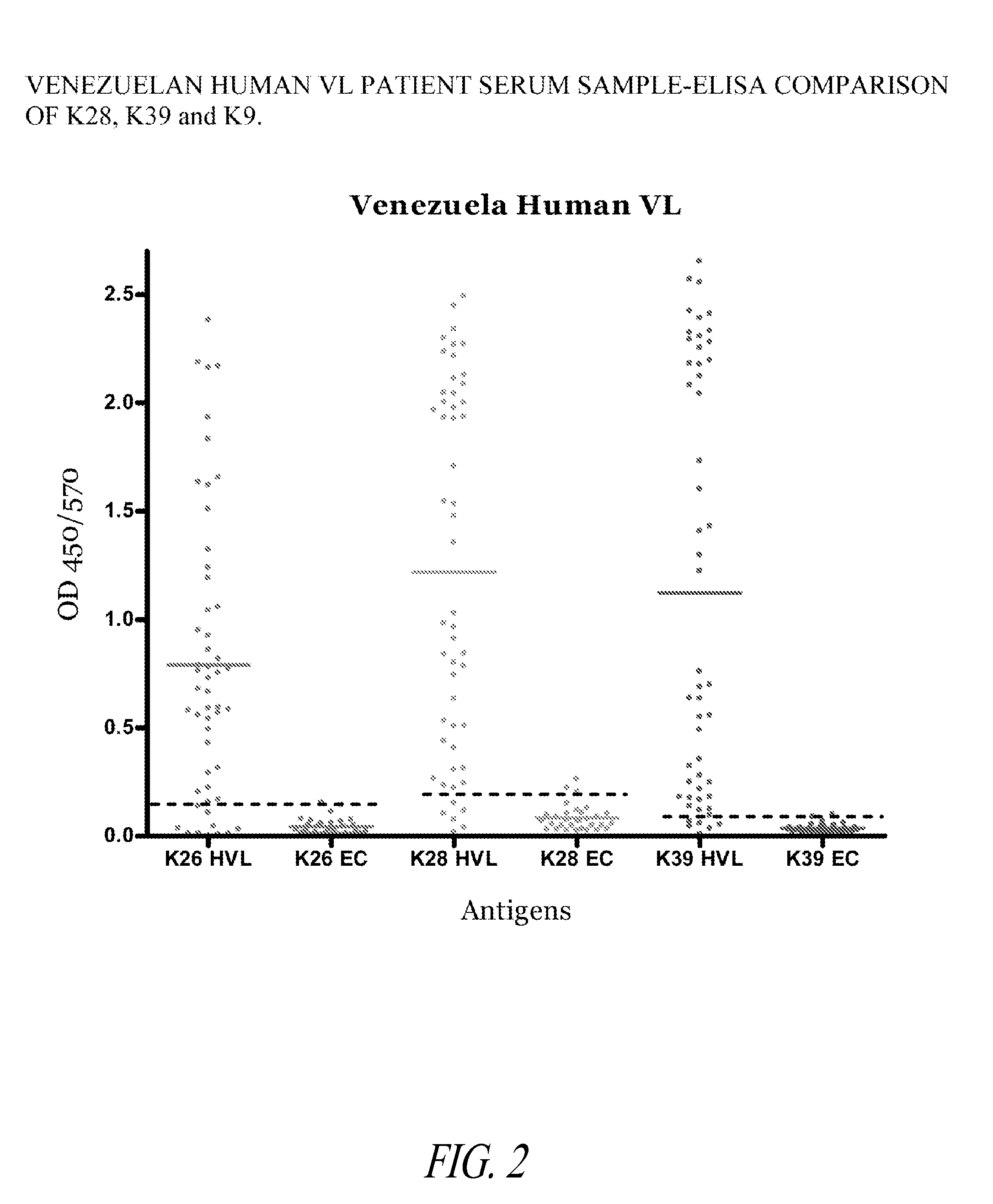Fusion proteins and their use in the diagnosis and treatment of leishmaniasis
a technology of leishmaniasis and fusion proteins, applied in the field of fusion proteins, can solve the problems of difficult detection of leishmaniasis with standard techniques, symptomatic visceral disease often ending in death, and serious leishmaniasis, and achieve the effect of treating and preventing leishmaniasis
- Summary
- Abstract
- Description
- Claims
- Application Information
AI Technical Summary
Benefits of technology
Problems solved by technology
Method used
Image
Examples
example 1
Cloning and Expression of Leishmania Fusion Polypeptide
[0177]The present invention relates to a synthetic gene construct, referred to as K28, comprising sequences derived from 3 Leishmania donovani genes. The synthetic gene comprises partial DNA sequences of the K26 and K39 genes and the complete DNA sequences of the K9 gene. Additionally, the synthetic gene comprises a nine amino acid N-terminal motif, which includes 6 histidines (e.g., a 6× HIS epitope tag). The synthetic DNA construct was cloned into the NdeI / XhoI site of plasmid pCRX2.1 in order to express the fusion protein of this gene. The synthetic gene contains three 14 amino acid repeats of K26 encoded by SEQ ID NO: 1, two 39 amino acid repeats of K39 encoded by SEQ ID NO: 2, and the complete open reading frame for the K9 gene encoded by SEQ ID NO: 3. This fusion construct was designed to improve the diagnostic potential of each of these single proteins into one molecule and offers a broader coverage, increased sensitivit...
example 2
Detection of Asymptomatic and Sub-Clinical Visceral Leishmania Infections in Humans Using a K28 Polypeptide
[0178]This Example illustrates the increased detection sensitivity of Leishmania infection in humans using a fusion polypeptide of the invention, prepared as described in Example 1, in an ELISA format.
[0179]The ELISA assays were performed as follows. Three series of Polysorp 96 well plates (Nunc, Rochester, N.Y.) were each coated with 2 μg / ml of a different recombinant antigen in bicarbonate buffer overnight at 4° C. and blocked for 2 hours at room temperature with PBST with 1% (w / v) BSA on a plate shaker. Sera were diluted appropriately to 1 / 200 in PBST with 0.1% BSA, added to each well and plates were incubated at room temperature for 2 hours with shaking. Plates were washed with PBST with 0.1% BSA and then HRP conjugated IgG immunoglobulin (Sigma, St. Louis, Mo.), diluted 1:10000 in PBST and 0.1% BSA, was added to each well and incubated at room temperature for 60 minutes ...
example 3
Detection of Asymptomatic and Sub-Clinical Visceral Leishmania Infections in Canines Using a K28 Polypeptide
[0182]This Example illustrates the increased detection sensitivity of Leishmania infection in canines using a fusion polypeptide of the invention, prepared as described in Example 1, in an ELISA format.
[0183]The ELISA assays were performed as described in Example 2, except that 4 different recombinant antigens were used. Four series of Polysorp 96 well plates were each coated with 2 μg / ml of either K9, K26, K28, or K39 recombinant antigens. Venezuelan canines with visceral leishmaniasis (VL) were identified based on serology (e.g., IFAT or IHA immunofluorescence or hemaglutination), clinical symptoms (e.g., malaise, diarrhea, splenomegaly and hepatomegaly) and whole lysate ELISA.
[0184]The results depicted in FIG. 3 show that K28 identified a significantly greater number of cases than either of the other three antigens used alone. This indicates that using K28 provides increa...
PUM
| Property | Measurement | Unit |
|---|---|---|
| temperature | aaaaa | aaaaa |
| fluorescent | aaaaa | aaaaa |
| luminescent | aaaaa | aaaaa |
Abstract
Description
Claims
Application Information
 Login to View More
Login to View More - R&D
- Intellectual Property
- Life Sciences
- Materials
- Tech Scout
- Unparalleled Data Quality
- Higher Quality Content
- 60% Fewer Hallucinations
Browse by: Latest US Patents, China's latest patents, Technical Efficacy Thesaurus, Application Domain, Technology Topic, Popular Technical Reports.
© 2025 PatSnap. All rights reserved.Legal|Privacy policy|Modern Slavery Act Transparency Statement|Sitemap|About US| Contact US: help@patsnap.com



